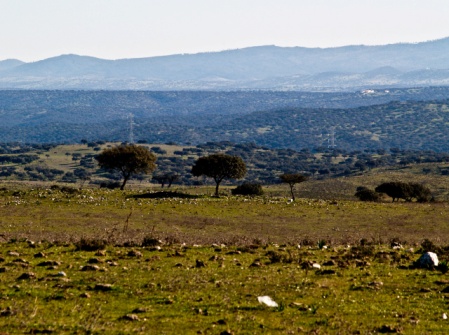Montemor-o-Novo (Central Alentejo) is characterised by its flat or gentle hills morphology, mostly poor and thin soils, and dry Mediterranean climate. It has very hot and dry summers and mild winters with rain concentrated in autumn and spring. The gentle hills are separated by small valleys, mostly with seasonal watercourses. The environmental conditions limit agriculture and human activities.
The region is and has always been sparsely populated, with the population concentrated in very large villages and in a few towns towns. Alentejo had a total of 749055 residents in 2010 (INE 2011). Montemor-o-Novo has an average of 14.8 persons per Km2; while the average for Alentejo is 23.7 and for Portugal, 115.4 (INE 2011). Alentejo is also characterised by an aging population, 27,4 % of residents in Montemor are older than 65 (Table 2); while the average for Alentejo is 23.1% and for Portugal, 18.2 (INE 2011).
The land cover is dominated by the silvo-pastoral montado, a savannah like open forest with cork and oak, and grazing in the undercover. Themontado is a mosaic of trees and open open pastures. There are areas where olive groves dominate. Mainly in the areas around towns and villages there is a mosaic of olives, fruit trees, pastures and vegetable gardens. Particularly around the town of Montemor-o-Novo, besides the traditional land cover with new houses (which are larger than the traditional ones). There is a low but still clear “peri-urbanization” of the landscape in these smaller areas. Cereals are found in the most fertile soils and flat areas.
The specific character of these landscapes is today highly valued from the perspectives of the multiple goods and services it supports. Nevertheless, the existing land use systems are threatened by extensification and abandonment, on one side, or by replacement by more intensive and commercial oriented systems. In the last two decades, there has been in different local areas a process of intensification, with focus on wine and intensive olive production. But it is still the livestock breeding and the cork harvest that dominates the majority of land use in Montemor, mostly under the montadosystem. The last few decades signaled intensifying livestock production scales in Montemor-o-Novo, linked to mechanization of the shrub cleaning, changes in livestock breeds into heavier and more productive ones and to CAP’s cattle premium payment.
The amenity potential of the landscape is recognized, but is not significant. A main challenge is finding new management paradigms and strategies that make it possible to preserve the values of the region while accepting the required changes.
In Montemor-o-Novo, as in Alentejo, there is a duality in the property regime (with different dynamics, issues and priorities, as well as different types of impacts in the spatial landscape). While large properties (100-1000 or more ha) are clearly dominant at the spatial level, they are outnumbered in their frequency by the small properties that exist mainly around the villages or that contain more productive soils.
Historically, the latifundia managed extensively but commercially, are owned by families with the dominant economic and social power. While traditional small scale farming in the surroundings of villages and town (or in areas of more fertile and relative water abundance) has mostly been subsistence farming with limited commercial orientation. Owners of these small farms have combined the farming of their land with other income sources, both service activities in the nearby towns, and day work at the large scale estates, therefore keeping an available working force for the large estates, when needed. They could also have an income from buying and selling vegetables or sheep, specialised machinery work, etc. The social structure in Alentejo, deeply rural until today, is thus symbolically marked in a particular way by this long-term dichotomy between large owner’s families and small owners or rural workers, with the small scale farmers being a particular sub-class of the later. This is the case also in Montemor-o-Novo.
The agricultural sector and organisations are undoubtedly dominated by the very large owners, members of the wealthier families in the region and with strong connections on the economic and political national power spheres. Large-scale farming are represented in national organisations and the dominating farming issues in the region emerge from the extensive large scale cattle and cereal production.
A variety of possibilities in accessing the use of the land exist: ownership, formal renting, and informal agreement on use of land. It is common to have several tenants (formal or informal) exploring the same area for their different components (pasture, honey, hunting, e.g.).
The service sector stands as the major employer and gross benefit producer in Central Alentejo, Alentejo and Portugal (INE 2009). Agriculture, hunting, fishing and forestry revealing the lowest values for both indicators: it employed 9 700 people and generated 137 million euros of gross added value in Central Alentejo (where Montemor-o-Novo is located); the values for Alentejo being 45200 people and 847 million euros of gross value added. GDP per capita in the Alentejo is 14.7 thousand euros (95.6% of the average for Portugal) (INE 2009). Nevertheless, due to its location less than 100 km from the large metropolitan area of Lisbon, the municipality of Montemor-o-Novo benefits much more than other parts of the region, from the income generation and activity of the metropolitan area.
Since Portugal became a member of EU, the national agricultural policy has been defined by the application or in reaction to the CAP orientations and payment structure. The two pillars of the CAP are hardly integrated. There is from one side production payments, and from the other, rural development programs. From the production side, most relevant for the region of Montemor-o-Novo and in particular the silvo-pastoral system, is the cattle headage payment, still coupled in the Portuguese case. Beef cattle receives the highest payments, in relation to sheep, and agriculture figures show a constant increase in cattle grazing density both in open grazing areas and in the montado. The issue is not only that livestock density increases, but also that cattle replaces the small ruminants, sheep and goats. The heavy cattle races are too demanding and damaging for the balance of the silvo-pastoral system and the underlying biophysical assets, and as such the survival of the whole land use system might be threatened.
Montemor-o-Novo has two Natura 2000 Site (Monfurado and Cabrela). The Sites are object of several types of classifications and conservation oriented schemes which often create tensions with land owners.
As for Rural Development initiatives, they have since their inception been managed by Local Development Associations, closely linked to the social sector and the support of the most disfavoured population groups, e.g. agricultural workers and others. These Associations have, since the late eighties, had an extremely important role in supporting the local communities and improving life quality. But they have kept a distant relation to farming and the farming organizations – even if their motivations and interests could be combined. The social and environmental concern and valuation of the montadohas therefore no real representation within the farming sector in Alentejo, and the new roles of the traditional farming systems do not have, so far and in general, a common and well acknowledged representation.
Furthermore, planning in Portugal has strong urban roots and still relates mostly to the planning of urban areas functioning and expansion. The rural has so far not been a concern of the planning sector. Plans indicate zoning of the rural territory, but they are mainly indicative, with no implementation strategy in existence. In the planning sector, therefore, there is an absence of a body able to deal with visions and management of this space.

This image shows the Montado in Alentejo in the winter (image courtesy of Filipe Barroso).

This image shows the Montado in Alentejo in the summer (image courtesy of Filipe Barroso).






